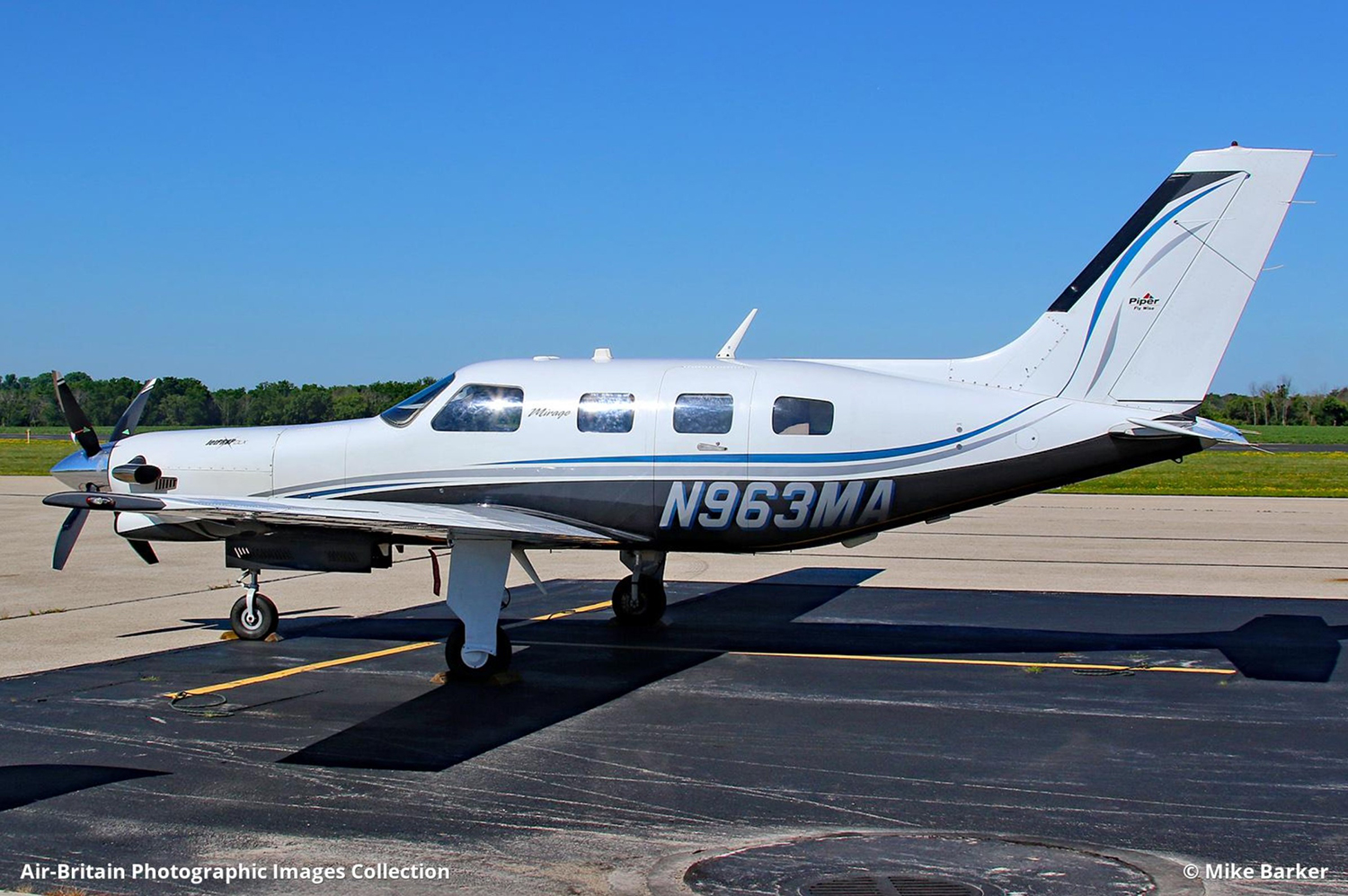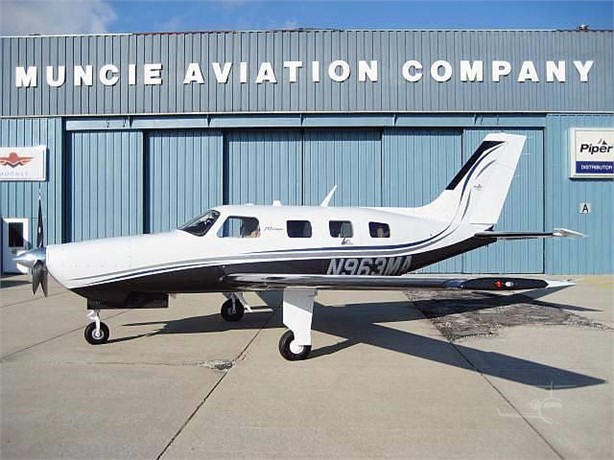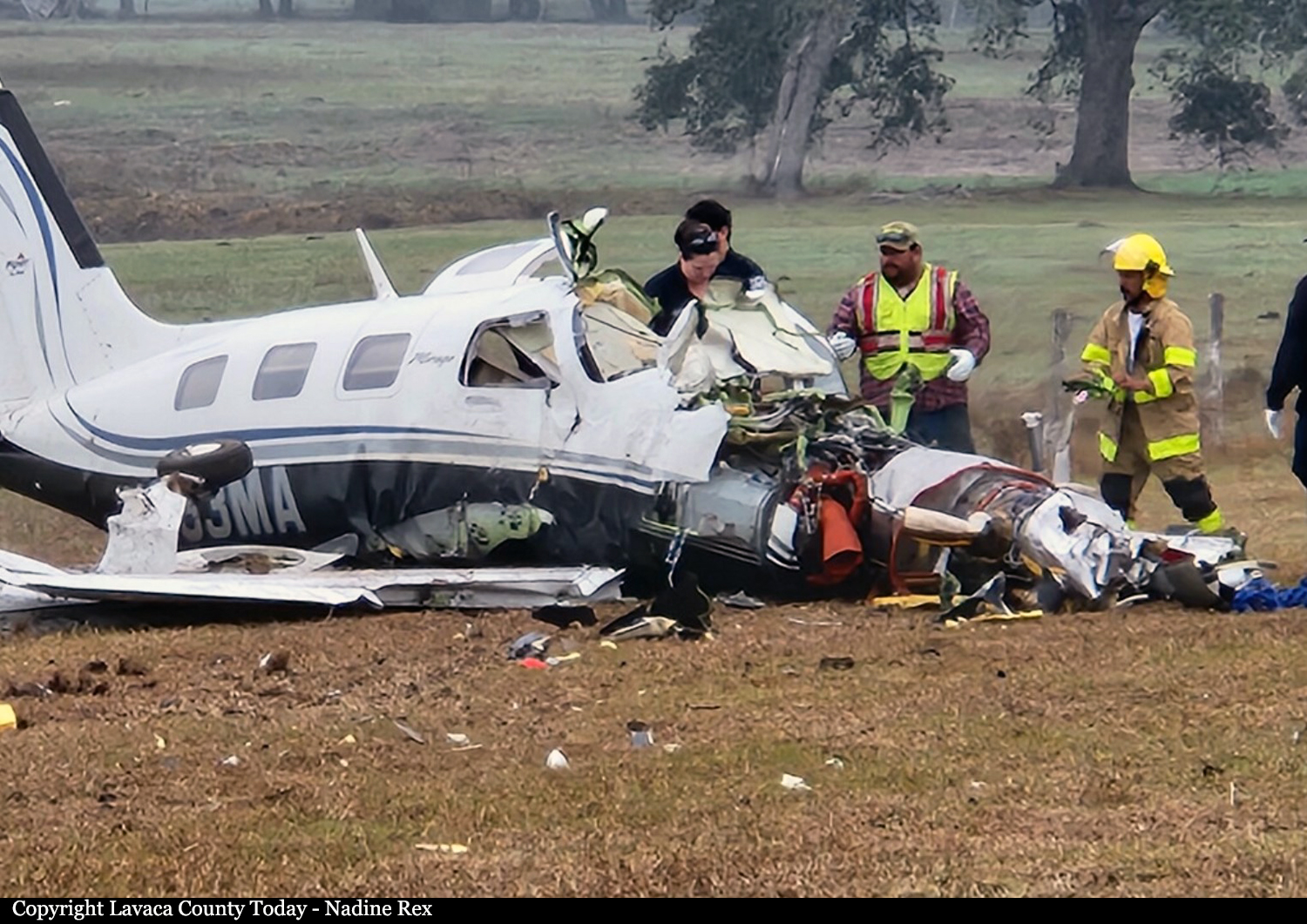You are using an out of date browser. It may not display this or other websites correctly.
You should upgrade or use an alternative browser.
You should upgrade or use an alternative browser.
Malibu down - Yoakum TX (T85) - 1-17-23 - 4 fatal
- Thread starter Van Johnston
- Start date
RyanShort1
Final Approach
That wing looks upside down... while the fuselage is upright. Must've been a pretty dramatic impact.
Not sure if the flight track is accurate or not, but assuming it is, it's interesting how they were lined up on final and then suddenly took a hard right turn. In any case, sad deal.
Flying Doc
Pre-takeoff checklist
- Joined
- Jun 5, 2020
- Messages
- 177
- Display Name
Display name:
FlyingDoc
Also looks like the plane was climbing about 400 feet while its groundspeed went south into the 50s kts. Where they doing a go/around and messed up?
Daleandee
Final Approach
- Joined
- Mar 4, 2020
- Messages
- 6,307
- Display Name
Display name:
Dale Andee
Also looks like the plane was climbing about 400 feet while its groundspeed went south into the 50s kts. Where they doing a go/around and messed up?
If the numbers are accurate it does seem to indicate they were flying very close to, or even at, stall speed. If true the question is, why?
Sad to see this ...
dans2992
En-Route
- Joined
- Jan 7, 2013
- Messages
- 3,892
- Display Name
Display name:
Dans2992
Almost looks like someone just grabbed the yoke and hauled back…. :/
https://globe.adsbexchange.com/?icao=ad685f
https://globe.adsbexchange.com/?icao=ad685f
A1Topgun
Cleared for Takeoff
Wonder if the PIC had a medical issue and right seat passenger tried to fly the plane. No post crash fire, fuel?
texasclouds
En-Route
Not sure of the weather there, but central TX had thick LIFR fog until about 1-2pm yesterday. I wonder if he got spacial D in IMC.
OP, check the date in your thread title. We are now in the year 2023.
OP, check the date in your thread title. We are now in the year 2023.
texasclouds
En-Route
Van Johnston
Pattern Altitude
OP, check the date in your thread title. We are now in the year 2023.
Doh; thanks.
texasclouds
En-Route
Meters from nearby Victoria are below, but my mother in law lives much closer to Yoakum than Victoria and she reported dense fog until 1pm. Below is a picture of my scratched flight that morning near Bryan TX.
ARCHIVED METAR OF: 20230117 // FROM: 14 TO: 18 UTC
AIRPORTS REQUESTED: KVCT
KVCT 171451Z 00000KT 1 1/2SM BR OVC010 19/19 A2986 RMK AO2 SLP110 T01890189 53022
KVCT 171553Z 13006KT 3SM BR BKN007 OVC013 20/19 A2987 RMK AO2 T02000189
KVCT 171751Z 18010KT 8SM SCT013 23/18 A2983 RMK AO2 SLP101 T02330183 10239 20178 58009
KVCT 171813Z 19010KT 9SM SCT024 25/18 A2982 RMK AO2 T02500183
KVCT 171820Z 15011KT 9SM BKN022 26/18 A2982 RMK AO2 T02560183

ARCHIVED METAR OF: 20230117 // FROM: 14 TO: 18 UTC
AIRPORTS REQUESTED: KVCT
KVCT 171451Z 00000KT 1 1/2SM BR OVC010 19/19 A2986 RMK AO2 SLP110 T01890189 53022
KVCT 171553Z 13006KT 3SM BR BKN007 OVC013 20/19 A2987 RMK AO2 T02000189
KVCT 171751Z 18010KT 8SM SCT013 23/18 A2983 RMK AO2 SLP101 T02330183 10239 20178 58009
KVCT 171813Z 19010KT 9SM SCT024 25/18 A2982 RMK AO2 T02500183
KVCT 171820Z 15011KT 9SM BKN022 26/18 A2982 RMK AO2 T02560183

Last edited:
FlightmechH3
Pre-takeoff checklist
- Joined
- Dec 30, 2021
- Messages
- 129
- Display Name
Display name:
FlightmechH3
Reported cloud deck 100' AGL.
Yeah, he should have been diverting to another airport.
Get-there-itis strikes again.
Yeah, he should have been diverting to another airport.
Get-there-itis strikes again.
sourdough44
En-Route
Same story, different scenario. Yes, delay, land short or divert.
Kenny Taylor
Pre-takeoff checklist
Looks like a missed approach gone wrong.
Applying some IR student book work
PaulS
Touchdown! Greaser!
Tragic accident. There is a youtube pilot, Malibu Flyer, who was flying in pretty low conditions with a gusty wind. He decided a no flap landing at 90kias was the right thing to do. He touched down, bounced and initiated a go-around on the bounce. He jammed the throttle forward and proceeded to grease the airplane onto the runway. The engine stopped producing power, luckily he handled the bounce correctly and didn't porpoise, but the engine stalled, he didn't know why, he was lucky.
He was trying to figure out what happened after the fact, he had pretty good video of the instruments, the airplane and him. What he did is went from basically almost zero power throttle closed to throttle wide open with almost a panicked jam. The egts and chts dived, the rpm dropped. So he landed. This happened very quickly.
What I think happened is the engine had cooled down during the descent, by jamming the throttle rather than opening it over 3 or 4 seconds, the fuel controller loaded the engine up with fuel before the turbos, which weren't spooled up from a long low power descent, could supply enough air to burn it. He flooded out the engine, IMO.
I wonder if this is what happened to this guy. I was trained a long time ago, jamming the throttle in a piston airplane is a bad thing to do to the engine for many reasons. Jamming the throttle in a turbo is even worse. A go around or going missed should be an orderly, controlled process. Yes, sometimes there is urgency, but none of the motions should look anything like panic. Bad things might happen.
Unfortunately, sometime later, this guy wrecked his Malibu, had no insurance, and is now flying a Cherokee.
If you start around 17:30 you can see the Malibu landing.
He was trying to figure out what happened after the fact, he had pretty good video of the instruments, the airplane and him. What he did is went from basically almost zero power throttle closed to throttle wide open with almost a panicked jam. The egts and chts dived, the rpm dropped. So he landed. This happened very quickly.
What I think happened is the engine had cooled down during the descent, by jamming the throttle rather than opening it over 3 or 4 seconds, the fuel controller loaded the engine up with fuel before the turbos, which weren't spooled up from a long low power descent, could supply enough air to burn it. He flooded out the engine, IMO.
I wonder if this is what happened to this guy. I was trained a long time ago, jamming the throttle in a piston airplane is a bad thing to do to the engine for many reasons. Jamming the throttle in a turbo is even worse. A go around or going missed should be an orderly, controlled process. Yes, sometimes there is urgency, but none of the motions should look anything like panic. Bad things might happen.
Unfortunately, sometime later, this guy wrecked his Malibu, had no insurance, and is now flying a Cherokee.
If you start around 17:30 you can see the Malibu landing.
Rockymountain
Pre-takeoff checklist
The plane in this accident was not a piston. Was a Mirage converted to a jetprop. Very unlikely an engine issue. But the plane for whatever reason was too slow.
PaulS
Touchdown! Greaser!
The plane in this accident was not a piston. Was a Mirage converted to a jetprop. Very unlikely an engine issue. But the plane for whatever reason was too slow.
Ah, details...., thank you.
MalibuJim
Pre-takeoff checklist
- Joined
- May 14, 2013
- Messages
- 109
- Display Name
Display name:
MalibuJim
What makes you think this was a conversion? Everything I see online, including the performance of this last flight, indicates it was a piston. But some flights show much higher "Turbine" performance.The plane in this accident was not a piston. Was a Mirage converted to a jetprop. Very unlikely an engine issue. But the plane for whatever reason was too slow.
midwestpa24
En-Route
- Joined
- Mar 4, 2016
- Messages
- 4,989
- Display Name
Display name:
midwestpa24
What makes you think this was a conversion? Everything I see online, including the performance of this last flight, indicates it was a piston. But some flights show much higher "Turbine" performance.

midwestpa24
En-Route
- Joined
- Mar 4, 2016
- Messages
- 4,989
- Display Name
Display name:
midwestpa24
Granted, I can also find a photo of it as a piston. One would assume it would not be retrofit back into a piston after having a Jetprop modification done.

midwestpa24
En-Route
- Joined
- Mar 4, 2016
- Messages
- 4,989
- Display Name
Display name:
midwestpa24
This crash photo also shows the remains of the turbine engine.


Archer Jack
Pre-takeoff checklist
Correct me if I'm wrong but I thought a Mirage came as a turboprop. If it has a piston engine it's called a Malibu.What makes you think this was a conversion? Everything I see online, including the performance of this last flight, indicates it was a piston. But some flights show much higher "Turbine" performance.

midwestpa24
En-Route
- Joined
- Mar 4, 2016
- Messages
- 4,989
- Display Name
Display name:
midwestpa24
Correct me if I'm wrong but I thought a Mirage came as a turboprop. If it has a piston engine it's called a Malibu.
The Malibu and Malibu Mirage were both piston versions from the factory, now known as the M350. The factory turbine was the Malibu Meridian, and is now the M500 and M600.
Correct me if I'm wrong but I thought a Mirage came as a turboprop. If it has a piston engine it's called a Malibu.
Mirage came with more powerful Lycoming engine than the Malibu's Continental.
texasclouds
En-Route
I’ve never flown one, but my boss sold his after it proved to be limited on capacity/range for charter ops. Seems like five peeps is a lot for that long of a flight. No fire makes me think no fuel left.
Rockymountain
Pre-takeoff checklist
Piper PA46 derivatives
Malibu 1984-1988-Continental 520 or 550 engine
Mirage 1989-2015- Lycoming TIO540AE2A engine
M350 2015-present Lycoming TIO540AE2A engine
Jetprop conversion of Malibu or Mirage to PT6-34 or 35 engine
Meridian 1999-2015 Factory PT6-42A
M500 2015-present Factory PT6-42A
M600 2016-present Factory PT6-42A
Malibu 1984-1988-Continental 520 or 550 engine
Mirage 1989-2015- Lycoming TIO540AE2A engine
M350 2015-present Lycoming TIO540AE2A engine
Jetprop conversion of Malibu or Mirage to PT6-34 or 35 engine
Meridian 1999-2015 Factory PT6-42A
M500 2015-present Factory PT6-42A
M600 2016-present Factory PT6-42A
KeepWatch
Pre-takeoff checklist
- Joined
- Mar 23, 2020
- Messages
- 142
- Display Name
Display name:
KeepWatch
I heard about 4th hand from the surviving passenger another detail about this crash. It was obvious from the account I heard that several terms were probably misheard and repeated, but the one thing that stuck out was this:
The pitch up was quickly followed by the engine quitting. Sure seems to point to a fuel starvation situation that was the last link in a chain of events that should have never happened.
The pitch up was quickly followed by the engine quitting. Sure seems to point to a fuel starvation situation that was the last link in a chain of events that should have never happened.
455 Bravo Uniform
Final Approach
What typically stalls a carbed piston engine (which this was not) on slamming throttle from closed to wide-open is the immediate loss of vacuum, intake velocity slows, fuel “drops out” (condenses), and the engine starves for fuel, not floods. That’s what accelerator pumps are for, to squirt additional fuel when the intake signal can’t call for all that it needs. On cars it’s a “bog” or hesitation and when bad results in a stall. On some carbs (auto) there is a pump volume and duration that’s adjustable (like on a Holley Double Pumper). On planes, an A&P might should chime in.
benyflyguy
En-Route
Happened to me once on a go around with my CFI on board. Carbed 470 in a 182. Scared the crap out of me but recovered. Fortunately had runway to spare and settled her down. Learned to slowing push that it. It’s not like a video game!What typically stalls a carbed piston engine (which this was not) on slamming throttle from closed to wide-open is the immediate loss of vacuum, intake velocity slows, fuel “drops out” (condenses), and the engine starves for fuel, not floods. That’s what accelerator pumps are for, to squirt additional fuel when the intake signal can’t call for all that it needs. On cars it’s a “bog” or hesitation and when bad results in a stall. On some carbs (auto) there is a pump volume and duration that’s adjustable (like on a Holley Double Pumper). On planes, an A&P might should chime in.
sourdough44
En-Route
And what some of us wouldn’t give for an airplane like that?
I do realize one could say that about many accidents.
I do realize one could say that about many accidents.
KeepWatch
Pre-takeoff checklist
- Joined
- Mar 23, 2020
- Messages
- 142
- Display Name
Display name:
KeepWatch
Happened to me once on a go around with my CFI on board. Carbed 470 in a 182. Scared the crap out of me but recovered. Fortunately had runway to spare and settled her down. Learned to slowing push that it. It’s not like a video game!
I was actually thinking more along the lines that so little fuel was onboard that a pitch up was enough to starve the turbine. But the preliminary report should have some pretty solid info on what the case was for fuel quantity.
455 Bravo Uniform
Final Approach
Happened to me once on a go around with my CFI on board. Carbed 470 in a 182. Scared the crap out of me but recovered. Fortunately had runway to spare and settled her down. Learned to slowing push that it. It’s not like a video game!
Same here, but it was a touch & go at El Dorado, KS! Crazy winds and I was a bit “white knuckle” on all the controls to begin with. IO-470






